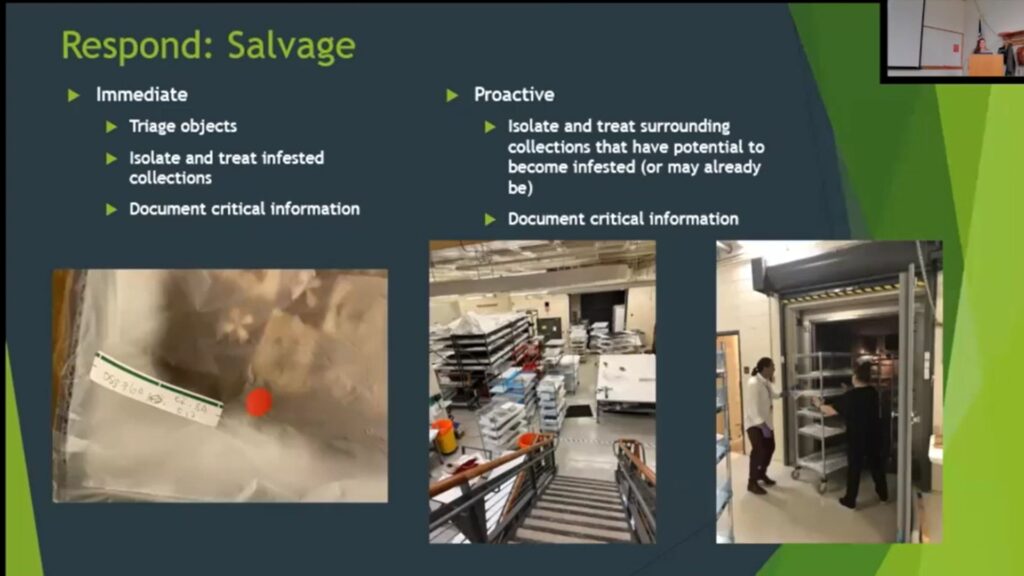Ring 2: FACING MONUMENTAL TASKS
“The Eleventh Plague: Responding to a Webbing Clothes Moth Infestation”
Presented by Christine Oricchio, Collections Specialist, National Museum of the American Indian (NMAI)
Summarized by Lauren Gottschlich
During WCG’s annual 3-Ring Circus, Christine Oricchio presented a lecture about every conservator’s nightmare, a large insect infestation. In her lecture, she presented the method by which Smithsonian’s National Museum of the American Indian (NMAI) battled one of their largest infestations of webbing clothes moths.
NMAI’s vast collection is predominantly composed of organic materials, and all of these are stored in one large space within the Suitland, Maryland facility. With the onset of the Coronavirus pandemic, a vast majority of the staff were not onsite from 2020 to 2022. This overwhelming amount of organic materials, in combination with low human traffic and monitoring, allowed the webbing clothes moths to infest and spread across the collection.
NMAI is no stranger to pest infestations and has a rigorous IPM strategy in place. However, with the largest infestation they had seen numbering in over 10,000 affected artifacts, this required a monumental response to eliminate the threat of the pests. Oricchio detailed the emergency response frameworks NMAI followed to eliminate the webbing clothes moths. The two main frameworks were the Smithsonian Institution’s emergency response plan PRICE and FEMA’s Incident Command System (ICS). ICS is a framework that any institution can use to manage small or large “Incidents.”

NMAI staff populated the ICS framework in the structure pictured above. In using planned phases for the emergency response, the staff were able to ensure safety protocols were followed, information was documented, materials were available, and the plan had the desired results. The incident commander led the response and administration ensured that the finances were covered. Shift leaders documented the achievements at the end of the shifts, led freezer rotations, and monitored safety. Because these activities generated so much information, registration staff were designated as the documentation specialists.
Team members were broken into four teams and came from every and any department. The four designations were pullers, wrappers, rotators, and inspectors. They worked in conjunction to pull objects for wrapping, seal the artifacts in polyethylene bags, ensure objects were correctly labeled, and inspect objects for signs of infestation. Initially, this team involved only staff trained in object handling for their every-day jobs, however, after protocols were solidified, this turned into anyone who was willing to lend a hand after some training.
Because pests are mobile, the general plan of inspect, assess, respond (salvage) and respond (monitor) was adaptable and repeatable as necessary until the conclusion of the emergency. As pests move, other objects could be infected so monitoring and assessments are ongoing.
Oricchio detailed all of the resources that were necessary to handle the emergency. In total, they had a core team of 25 people and an additional 50 trained rotation staff. Physical resources included 125 multilayered carts, thousands of feet of polyethylene sheeting and bags, 5 heat sealers, 3 wrapping stations, 3 freezers, and one anoxic chamber. In total it took 4 months to mitigate the initial wave of moths.
Currently, NMAI is working on the recovery stage to figure out how to move on from the infestation. This will likely include removing objects from isolation, cleaning off frass, webbing clothes moth carcasses, etc., documenting treatment, and returning the objects to their original shelving locations.
Want some tips and trick for how to handle this type of emergency. Check out some of Oricchio’s advice from her experience with the moth infestation:
- Make sure your workflows are effective before training volunteers.
- Identify what resources you need and work with your administration team to gather supplies.
- Identify where to isolate your collections.
- Create a glossary in advance. Many people have different names for the same object so agreeing on one set of terms can help reduce confusion.
- Store documentation in one central place where everyone involved has access.
- Continue monitoring as bugs are mobile. Create a log of where and when you inspect for pests so you know when infestations are new.
- Create an IPM plan before you have a pest infestation.
- Document lessons learned from past infestations and share that information.
- Take care of yourself and your volunteers.
- Make the process fun to avoid burnout or emotional fatigue.
